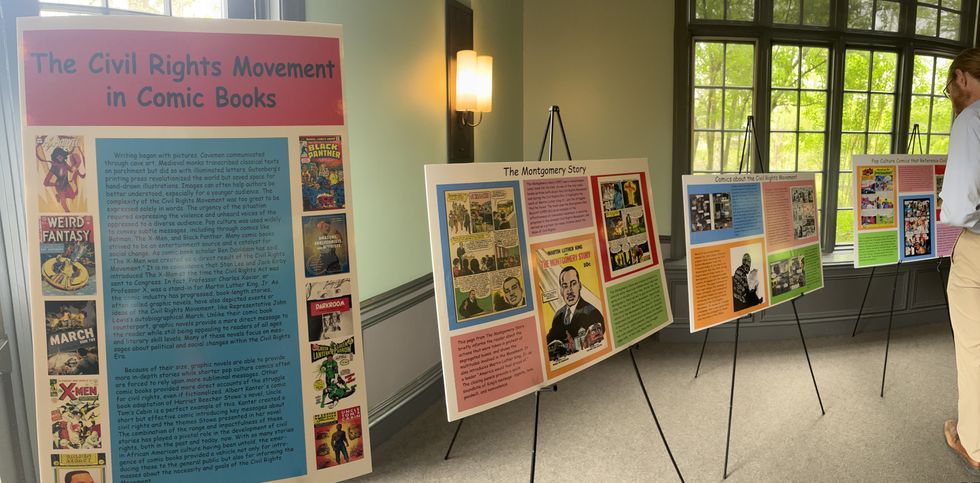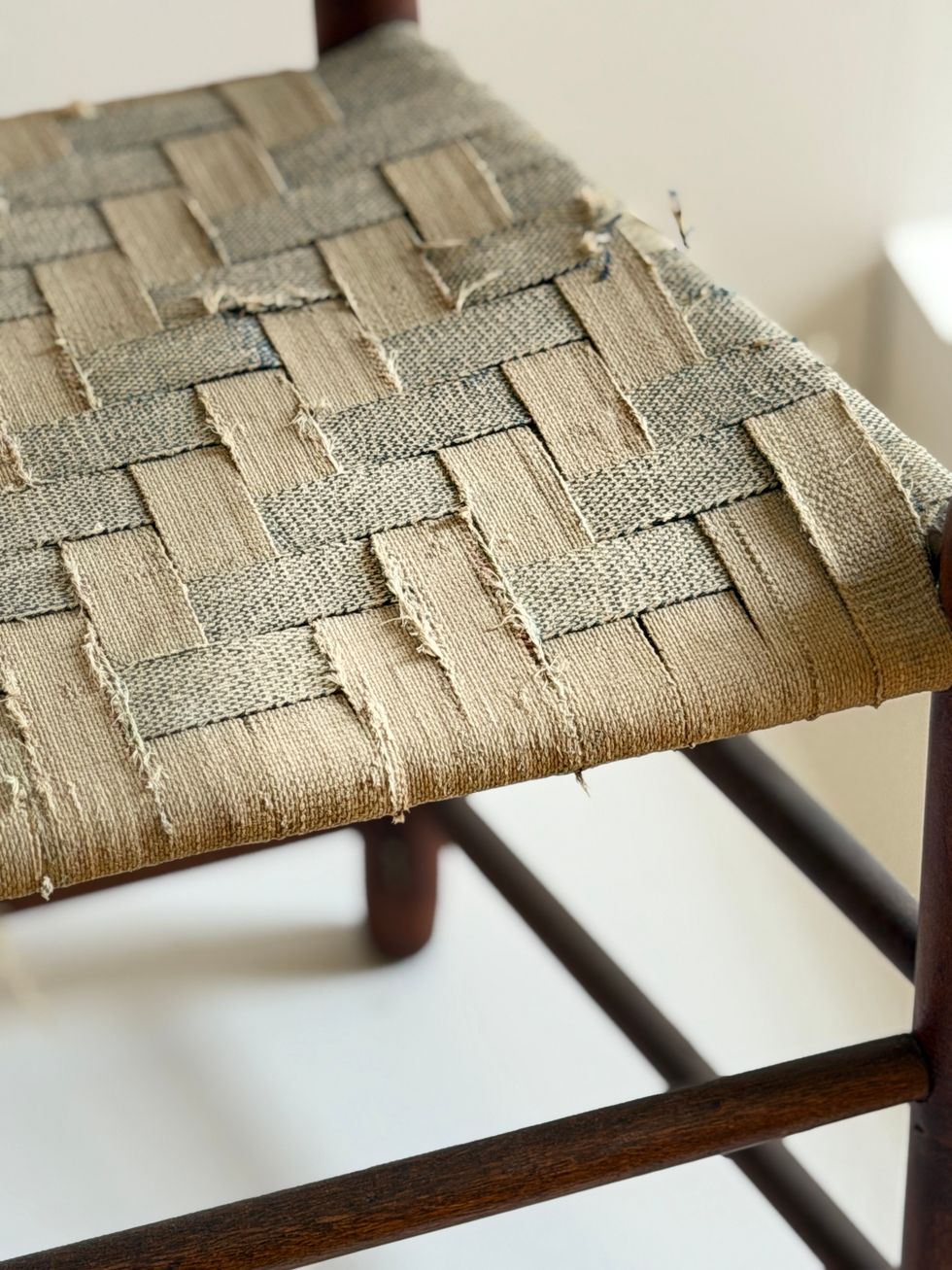Students share work at Troutbeck Symposium

Students presented to packed crowds at Troutbeck.
Natalia Zukerman

Students presented to packed crowds at Troutbeck.
The third annual Troutbeck Symposium began this year on Wednesday, May 1 with a historical marker dedication ceremony to commemorate the Amenia Conferences of 1916 and 1933, two pivotal gatherings leading up to the Civil Rights movement.
Those early meetings were hosted by the NAACP under W.E.B. Du Bois’s leadership and with the support of hosts Joel and Amy Spingarn, who bought the Troutbeck estate in the early 1900s.
Students from Arlington High School in LaGrange, New York, Kara Gordon, Nicolas Giorgi, Justin Meneses Aquimo, Akhil Olahannan, and Sheik Bowden together with their teacher Robert McHugh, made the historical marker possible by pursuing a grant from the Pomeroy Foundation.
“We believe strongly that markers help educate the public, encourage pride of place, and promote historical tourism,” said the foundation’s research historian and educational coordinator.
The ceremony began with a land acknowledgement by students Kennadi Mitchell and Teagan O’Connell from Salisbury Central School who gave thanks to the Muncie Lenape, Mohican and Schagticoke people by saying, “This guardianship has brought us to this very moment where we may learn from one another. We honor and respect the continuing relationship that exists between these peoples and this land.”
The crowd was then welcomed by Charlie Champalimaud who, with her husband, Anthony are the current owners of Troutbeck. Speeches were then given by Kendra Field and Kerri Greenridge, co-hosts of the event and founders of The Du Bois Forum, an annual retreat of writers, scholars, and artists engaged in historic Black intellectual and artistic traditions.
Field noted, “It is our genuine hope that the dedication of new historical sites, most especially this one, as part of our larger commitments, will make more complex, more diverse, and more complete the answer to the simple question ‘what happened here?’ and the closely related question, “what might happen next for generations to come?’”
MaryNell Morgan enchanted the audience with her a capella renditions of several of Du Bois’s “Sorrow Songs.”
Du Bois used these songs as part of the presentation of his 14 essays in his seminal work “The Souls of Black Folk,” first published in 1903.
A graduate of Atlanta University where Du Bois taught twice, Morgan sang a medley of songs explaining that the best way to understand “The Souls of Black Folk” is to understand the songs. In attendance at the evening event were also local officials, Amenia Town Supervisor Leo Blackman, and New York Assembly Members Didi Barrett and Anil Beephan. Closing remarks were given by Hasan Kwame Jeffries, Associate Professor at Ohio State University and one of the panelists for the Symposium.
Over the next two days, more than 200 middle and high school students from 16 regional public and independent schools converged to present and discuss their year-long research projects, uncovering the often-overlooked local histories of communities of color and other marginalized groups, answering the questions posed the night before, “what happened here and what might happen next for generations to come?”
Rhonan Mokriski, history teacher and educational director for the Troutbeck Symposium, emphasized the student-led nature of the forum by saying the directive was to “give it to the students and let them run with it.”
Through visual art, documentaries, personal and historical narrative, photographs, and multiple forms of storytelling, students skillfully presented their findings, revealing truths— often difficult ones—in the tradition of their predecessors who did so in the very same location.
Said Jeffries, “It’s one thing if the kids were doing research and then presenting in the, let’s say, school gymnasium, right? But to be able to do it here at Troutbeck, it adds the power of place and makes it all the more powerful.”

Student presentations ranged in topics from the Silent Protest of 1917 and its connection to the Amenia conference of 1916, the links between Lorraine Hansberry, Langston Hughes and Nina Simone, to local families, Amy Spingarn’s quiet activism, reimagining Du Bois’s ‘The Crisis’ through a modern contextualization that included the recent Supreme Court action on Affirmative Action.
Jeffries and Christina Proenza-Coles, a professor at Virginia State University spoke after each set of presentations, responding to and contextualizing the students’ work.
“These projects themselves are commemorations,” Poenza-Coles said. “They are themselves peaceful protests that are pointing us to a more just future.” Poenza-Coles emphasized the interconnectedness of past and present and stated, “Spaces that we would have thought about as white spaces, in fact, were also black and brown spaces from the beginning of history. Histories are completely intertwined.”
Blake Myers, programming, marketing, and culture manager at Troutbeck spoke passionately about the community effort it takes to put on the event year after year. She said that while making sure the program is sustainable, “It really is a replicable model,” and hopes to see other institutions, schools, and foundations adopt it as a teaching tool.
The rooms, walls, and wooded paths of Troutbeck reverberated for three days with stories, past and present, celebrations and revelations of untold narratives and marginalized voices.
Said Jeffries, “America is a product of decisions and choices that were made, and often those were bad decisions and bad choices from the perspective of somebody committed to human rights and to equality. But that’s our foundation, that’s how we started this whole thing.
“So, you have that on the one hand, but then despite the systems of oppression that are designed to do just that, you always have people willing to fight against it and people who are willing to carve out spaces to preserve, promote and protect their own humanity.”
Left to grapple with the complexities of historical memory and its implications for contemporary society, Jeffries offered, “The work that’s being done here, connected with Troutbeck, it’s not just about recovery and discovery, which is critical. But then the question is what do you do with it (the information)? How do we commemorate?
“What do we put in place physically so that we don’t forget. Often, we think about history and this question of ‘if you don’t remember the past, if you don’t remember the systems that are created, then we are doomed or bound to repeat it.’ But we’re not going to repeat anything because most of the stuff, we never stopped doing.”
There was some laughter from the audience and Jeffries concluded, speaking to the students, “But you’re waking up, remembering, focusing, and bearing witness so that we can finally disrupt it. We can finally stop doing the things from the past that have created and generated inequality in the present by focusing on this community that is very much doing the work.”
The Stone Round Barn at Hancock Shaker Village.
My husband Tom, our friend Jim Jasper and I spent the day at Hancock Shaker Village in Pittsfield, Massachusetts. A cold, blustery wind shook the limbs of an ancient apple tree still clinging to golden fruit. Spitting sleet drove us inside for warmth, and the lusty smells of manure from the goats, sheep, pigs and chickens in the Stone Round Barn filled our senses. We traveled back in time down sparse hallways lined with endless peg racks. The winter light was slightly crooked through the panes of old glass. The quiet life of the Shakers is preserved simply.

Originally founded in England, the Shakers brought their communal religious society to the New World 250 years ago. They sought the perfection of heaven on earth through their values of equality and pacifism. They followed strict protocols of behavior and belief. They were celibate and never married, yet they loved singing and ecstatic dancing, or “shaking,” and often adopted orphans. To achieve their millennialist goal of transcendental rapture, we learned, even their bedclothes had to conform: One must sleep in a bed painted deep green with blue and white coverings.
Shakers believed in gender and racial equality and anointed their visionary founding leader, Mother Ann Lee, an illiterate yet wise woman, as the Second Coming. They embraced sustainability and created practical designs of great utility and beauty, such as the mail-order seed packet, the wood stove, the circular saw, the metal pen, the flat broom and wooden clothespins.
Burning coal smelled acrid as the blacksmith fired up his stove to heat the metal rod he was transforming into a hook. Hammer on anvil is an ancient sound. My husband has blacksmithing skills and once made the strap hinges and thumb latches for a friend’s home.
Shaker chairs and rockers are still made today in the woodworker’s shop. They are well made and functional, with woven cloth or rush seats. In the communal living space, or Brick Dwelling, chairs hang from the Shaker pegs that run the length of the hallways, which once housed more than 100 Shakers.

In 1826, the 95-foot Round Stone Barn was built of limestone quarried from the land of the 3,000-acre Hancock Shaker Village. Its unique design allowed a continuous workflow. Fifty cows could stand in a circle facing one another and be fed more easily. Manure could be shoveled into a pit below and removed by wagon and there was more light and better ventilation.
Shakers called us the “people of the world” and referred to their farm as the City of Peace. We take lessons away with us, yearning somehow for their simplicity and close relationship to nature. One Shaker said, “There’s as much reverence in pulling an onion as there is in singing hallelujah.”
A sense of calm came over me as I looked across the fields to the hills in the distance. A woman like me once stood between these long rows of herbs — summer savory, sage, sweet marjoram and thyme — leaned on her shovel brushing her hair back from her eyes, watching gray snow clouds roll down the Berkshires.
More information at hancockshakervillage.org

Exterior of Lakeville Books & Stationery in Great Barrington.
Fresh off the successful opening of Lakeville Books & Stationery in April 2025, Lakeville residents Darryl and Anne Peck have expanded their business by opening their second store in the former Bookloft space at 63 State St. (Route 7) in Great Barrington.
“We have been part of the community since 1990,” said Darryl Peck. “The addition of Great Barrington, a town I have been visiting since I was a kid, is special. And obviously we are thrilled to ensure that Great Barrington once again has a new bookstore.”
The second Lakeville Books & Stationery is slightly larger than the first store. It offers more than 10,000 books and follows the same model: a general-interest store with a curated mix of current bestsellers, children’s and young readers’ sections; and robust collections for adults ranging from arts and architecture, cooking and gardening, and home design to literature and memoirs. Anne reads more than 150 new titles every year (as many as a Booker Prize judge) and is a great resource to help customers find the perfect pick.
A real-time inventory system helps the store track what’s on hand, and staff can order items that aren’t currently available. There is also a selection of writing and paper goods, including notecards, journals, pens and notebooks, as well as art supplies, board games, jigsaw puzzles and more. The owners scour the stationery trade shows twice a year and, Darryl says, “like to tailor what we offer to suit the interest of our customers in each market.”
The Pecks know what it takes to run a successful local enterprise. Darryl has a 53-year background in retail and has launched several successful businesses. He and Anne owned and operated a bookstore on St. Simons Island, Georgia, from 2019 to 2025. They are tapping into their local roots with both stores. They raised their family in Sharon, and their daughter Alice, a native of the Northwest Corner, manages the Lakeville store.

The family values the role that a retail store plays as a supporting partner in the community, and they prioritize great management in both locations, hiring and training talent from local communities. Their 10 team members across both stores are from the area, and two of the Great Barrington employees previously worked at Bookloft.
Darryl and Anne’s attention to customer service is everywhere apparent and adds to the enjoyable and irreplaceable in-store shopping experience. The books are in pristine condition, eliminating the risk of damage that sometimes occurs during shipping. This is especially important for books that will live on people’s shelves and coffee tables for years.
Darryl says, “People love the in-store discovery — you find books you didn’t know existed, which is very difficult to do on a website. Also, many customers depend on our recommendations when visiting. There is a saying about bookstores versus online ordering: We may not have exactly what you were looking for, but we have what you want.”
Lakeville Books & Stationery’s Great Barrington store is open 7 days a week, Monday-Saturday, 10 a.m. to 6 p.m., and Sunday, 11 a.m. to 5 p.m. Parking is available in the lot behind the building and in the parking lot behind the firehouse. The entrance to the store is accessible from the store parking lot.
For more information, go to lakevillebooks.com., and sign-up for the Lakeville Books newsletter.
Richard Feiner and Annette Stover have worked and taught in the arts, communications, and philanthropy in Berlin, Paris, Tokyo and New York. Passionate supporters of the arts, they live in Salisbury and Greenwich Village.